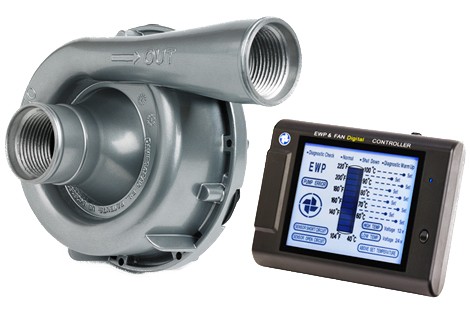
The Mechanical Water Pump is one of the last mechanical components of the modern engine which has long been considered an inefficient component that was designed as an accessory from the ever first engines. A mechanical belt driven pump installed on your car engines runs at the same speed as the engine regardless of how hot the engine is. Example: when travelling at high speeds down the freeway, the engine require less cooling as ram air is naturally cooling the engine however, the engine speed is high as is the mechanical water pump thus providing excessive cooling whilst draining the engine of power. Then in heavy traffic in high ambient, the engine is idling or slow and so is the belt driven mechanical pump, even though in this condition, extra coolant flow is required to cool the engine. The important improvement for your vehicle comes from the fact that most of the power the mechanical pump takes from the engine can be reclaimed with the use of an Electric Water Pump (EWP) hence the fuel savings. By removing the parasitic power losses of belt-driven water pumps, the EWP may provide up to 10kw of extra power and additional fuel savings. The engine power used by the mechanical pump increases as the cube of its speed – so when the mechanical pump speed doubles from idle speed say; 600rpm to 1200 rpm, the power it takes increases by eight times. Then another eight times going to 2400 rpm, and so on up to maximum engine speed. It is this extra power and torque that is released by deleting the mechanical pump that provides the fuel savings that is estimated to be 3.5% to 10%.
Major European Manufacturers have implemented EWP’s as standard issue on a number of their vehicles, we have documents show that and EWP uses 90% less energy than conventional systems, i.e.: the mechanical water pump. Other advantages will include lower emissions by virtue of faster engine warm up, better engine temperature management, eliminating engine heat soak and improved engine life.
Weight reduction is a key requirement of any automotive manufacturer seeking fuel savings and our EWP will weight around 900 grams up to 1,151 grams (dependent on EWP Type) compared to a typical mechanical pump at 3 to 4 kg. Not only is our EWP considerably lighter when matched against the mechanical pump but we would also be replacing several outdated components with one environmentally friendly product which once again helps improve performance and fuel consumption.
With an LCD EWP Controller (PATENTS: USA 6425353, EU 1133624, AUS 756453), the speed of the pump is managed by the controller, which varies the supply voltage to the pump and so varies the speed of the pump, hunting for a target temperature. When the engine reaches the target temperature the controller locks on, constantly changing the pump speed with traffic and throttle conditions, maintaining the target temperature independent of the engine speed.
Options for EWP® control:
- Use in conjunction with EWP®/Fan Digital Controller. The Digital Controller has a micro-processor which will run the EWP® at exactly the right flow rate to maintain your set, targeted engine temperature.
- Use in conjunction with Thermal Switch. Combine the EWP® with an adjustable Thermal Switch to add a cooling boost to an overheating mechanical pump cooling system.
- Continuous running. Wire the EWP® to the ignition for maximum cooling. This is suitable for race vehicles, very hot climates and chronically overheating engines.
- Many benefits of the EWP® include:

- Increased power and torque
- Increased cooling capability
- Eliminating heat soak
- Better control of engine temperature
- Flexible options for pump control
